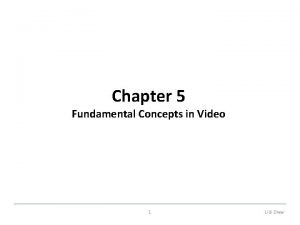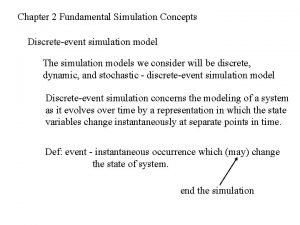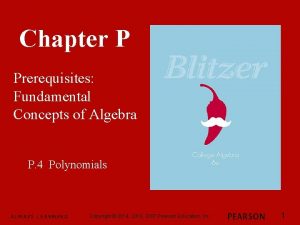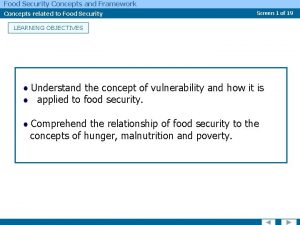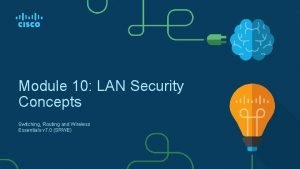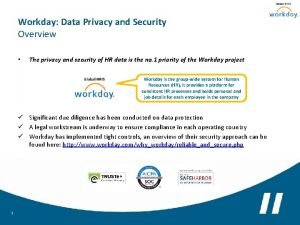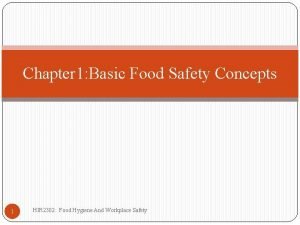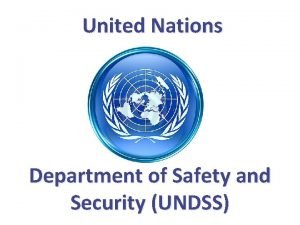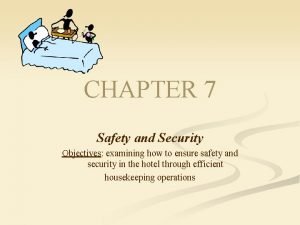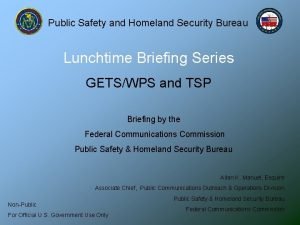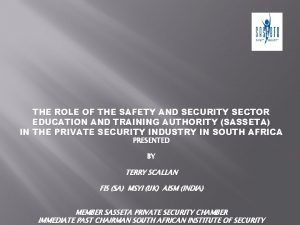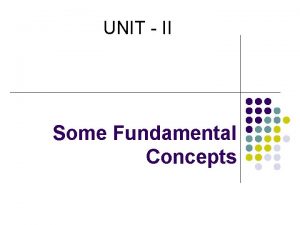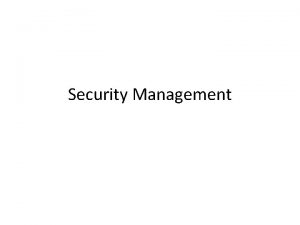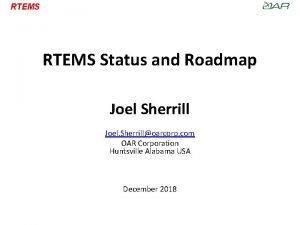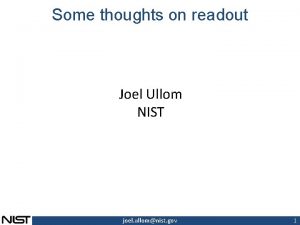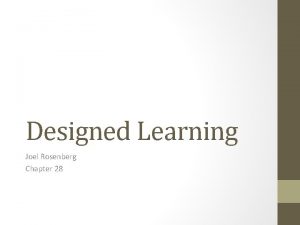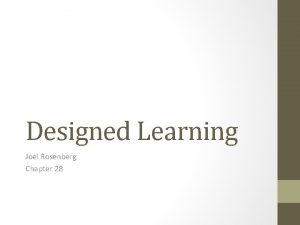Safety and Security Management Fundamental Concepts Joel Mc


























- Slides: 26

Safety and Security Management Fundamental Concepts Joel Mc. Namara

What is Safety & Security Management? A program that uses procedures and actions to prevent or reduce the chances of experiencing harm or loss.

Personal Safety & Security Management • What do you do on a daily basis that prevents or reduces the chances of you and your family suffering harm or loss? • Through experience and education, you have developed your own safety and security management program for dealing with day-to-day activities.

Organizational Safety & Security Management • Primary goal: To support XXXXXX programs! • Always ask what kind of an impact safety and security measures have on your programs, the people you serve, and your staff.

Safety & Security Management Program Goals 1. Clearly define safety and security roles and responsibilities. 2. Identify factors that increase risk and ways to reduce risk. 3. Develop written safety and security policies and procedures. 4. Train staff and encourage them to adopt safe and secure practices. 5. Plan ahead in case something bad happens.

1. Roles & Responsibilities • Who is responsible for what aspects of safety and security? • Are all staff aware of safety and security roles and responsibilities (and lines of authorities)? • Despite job titles, everyone is responsible for safety and security.

Safety & Security Focal Person • National staff, point person for safety and security issues. • Monitors current events. • Reviews policies and procedures. • Performs assessments. • Provides feedback to senior management on safety and security issues.

Safety & Security Committees • Effective safety and security planning is a team effort. • You should consider forming a small working group or committee that meets regularly to discuss country or office safety and security issues. • The committee should have representatives from management and staff. • Just remember that while teamwork is important, there should be a single, final decision-making authority on the team.

Benefits of a Team Approach • Each person has a unique set of experiences, knowledge and training that can contribute to the overall goal of reducing risk. • Involving several people in a process promotes different ideas and approaches to solving problems. • Collaborative efforts tend to have greater staff acceptance. • Dealing with safety and security issues carries a lot of responsibility; involving several people reduces the amount of stress on a single person.

Working with Other Humanitarian Organizations • Formal or informal cooperation on safety and security issues. • Build relationships with staff in other organizations to share general information about threats and specific safety and security measures you are using to reduce risk. • Check if organizations in your area are sharing information and collaborating on safety and security issues. If they are, get involved. If they are not, take the lead in getting others involved in a cooperative effort.

Crisis Management Teams • Senior management team that convenes during critical incidents. • Twice a year (minimum) training sessions. • Important considerations – Maintaining day-to-day operations – Capacity – Supporting policies and procedures

2. Identifying and Dealing with Risk • Threat and vulnerability analysis and assessments. • Mitigation and response measures (documented in your policies and procedures).

3. Policies & Procedures • Policies: high-level, overall plans and goals. • Procedures: steps and actions that accomplish the goal of a policy (sometimes called SOPs for Standard Operating Procedures). • Written and typically included in an operations manual or safety and security plan.

Why Policies & Procedures? • All staff will be working from the same established set of rules and guidelines. • Written policies and procedures (especially response plans) can be referred to during emergencies to help make decisions. • Written safety and security policies and procedures provide an outline for creating staff training.

Compliance • Successful safety and security management depends on compliance. • That means staff understands safety and security issues and follows policies and procedures.

Encouraging Compliance • Management and influential staff members need to set an example by following safety and security policies and procedures themselves (for example, always wearing seat belts). • The reasons behind policies and procedures should be explained and not treated as simply rules to be followed. • Because safety and security is important, supervisors might consider adding objectives that relate to safety and security to performance reviews and evaluations.

Encouraging Compliance What are some other ways of encouraging staff compliance of safety and security policies and procedures?

Policy & Procedure Review • Standard operating procedures should be reviewed at least every six months to ensure they are still appropriate for the threats they address. • Policies and procedures should be reviewed or revised if: – – New threats appear Existing threats become different The program experiences significant change of staff A safety or security incidentifies a need for change

Remember You can have the best policies and procedures in the world, but if no one follows them they are worthless.

4. Training • Gets staff members to think about safety and security issues. • Enhances overall office safety and security. • Prevents or minimizes potential incidents. • Training should not be a one-time event. Recurring training sessions are essential to reinforce knowledge and give staff members the opportunity to practice skills.

5. Planning • The process of determining how to carry out a course of action. • Anticipating future problems. • Understanding their potential impact. • Establishing policies and procedures. • Allocating resources.

Resistance to Safety & Security Management Practices • • Safety and security only applies to conflict areas. There has been no trouble or problems in the past. Risk is unavoidable, and part of the business. Safety and security management costs too much time and money (or interferes with programs). • Cultural aversion.

Handling Resistance How would you deal with staff resistance to a safety or security policy?

Making Good Decisions 1. What problem does the measure solve? – Sometimes it is easy to come up with proposed solutions that appear to address a problem but actually do not. 2. How well does the measure solve the problem? – Make sure a safety and security measure really solves a problem and is not just a token gesture. 3. How will you know the measure has been effective? - What can you see or measure that will indicate the measure has solved the problem?

Making Good Decisions 4. What other problems might the measure cause? – Sometimes safety and security measures can cause new problems (both big and little). You should always try to identify any new potential problems that may result from an implemented measure. 5. What are the economic and social costs of the measure? – How much will the measure cost, both in terms of money and impact to staff and operations.

Questions? More information at: http: //ngosecurity. googlepages. com/
 Private securty
Private securty Fundamental and powerful concepts
Fundamental and powerful concepts Fundamental concepts in video
Fundamental concepts in video Basic concepts of simulation
Basic concepts of simulation Concepts of managerial economics
Concepts of managerial economics What is idiolect
What is idiolect Four fundamental oop concepts
Four fundamental oop concepts Chapter p prerequisites: fundamental concepts of algebra
Chapter p prerequisites: fundamental concepts of algebra Chapter p prerequisites fundamental concepts of algebra
Chapter p prerequisites fundamental concepts of algebra Chapter p prerequisites fundamental concepts of algebra
Chapter p prerequisites fundamental concepts of algebra Occbio
Occbio Unit 1 review fundamental economic concepts answers
Unit 1 review fundamental economic concepts answers Time perspective in managerial economics
Time perspective in managerial economics Fundamental concepts in video
Fundamental concepts in video Food security concepts and frameworks
Food security concepts and frameworks Stp manipulation attack
Stp manipulation attack Workday soc report
Workday soc report Food safety concepts
Food safety concepts Wireless security in cryptography and network security
Wireless security in cryptography and network security Integrity in e commerce
Integrity in e commerce United nations department of safety and security
United nations department of safety and security Safety and security objectives
Safety and security objectives Cpi care welfare safety security
Cpi care welfare safety security Chemical safety and security
Chemical safety and security Public safety and homeland security bureau
Public safety and homeland security bureau Law, public safety, corrections and security answer key
Law, public safety, corrections and security answer key Sasseta ceo
Sasseta ceo


